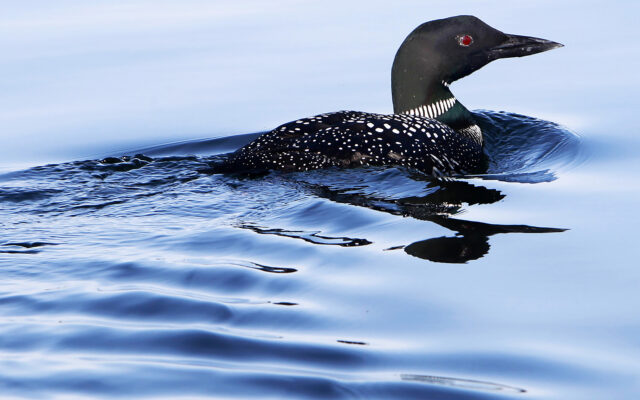
Help loons around the Fourth of July
Maine Audubon has been working to protect Common Loons for decades, as the Fourth of July is one of the busiest periods on Maine lakes and ponds. The potential for conflict is high, especially since many loons have vulnerable chicks by their sides in July or may still be nesting. In many cases, people may not realize they are presenting disturbances to wildlife. Gearing up toward the Fourth of July, Maine Audubon presents some important tips to help people understand how to celebrate while keeping our Common Loons safe.
Avoid nests, even in low-impact boats like kayaks and paddleboards
Ethan Daly, Maine Audubon Loon restoration technician, was checking in on a new loon nesting raft site recently at a lake in Cumberland County. As he stood on the shore, speaking with a volunteer about how to minimize human disturbances to the raft, he watched two paddle boarders weave in between the strategically placed raft and a nesting sign that reads “PLEASE STAY AWAY, LOONS NESTING.”
Luckily for the paddle boarders, the loons weren’t nesting on the raft at the time and had recently abandoned their nearby natural nesting site due to the noise from a float plane. The paddle boarders didn’t cause any disturbance that hadn’t already been done, but Daly still took the opportunity to inform them about the sign and do some outreach.
Follow boat wake rules
Most loons nest within a foot of the water’s edge, so they are especially vulnerable to washout from large waves. All motor boats on Maine lakes are required to travel at no-wake speeds when they are within 200 feet of shore or islands. Boats that facilitate wake surfing create even larger waves and can impact loon nests even when operating as far as 500-600 feet offshore! Earlier this year, a new law (LD 2284) was implemented specifically to address wakesurfing activity. It states that a person is prohibited “from operating a motorboat in less than 15 feet of water or within 300 feet of the shoreline when the motorboat is engaged in a wakesurfing activity.” Maine Audubon hopes boaters will respect these laws, slow down when moving through loon territory, and restrict wakesurfing activities to depths and distances even greater than required by law.
Avoid shooting fireworks near nesting loons
Multiple anecdotal incidents recorded on past July Fourth holidays show that fireworks and boats can create stressful situations for wildlife. The Loon Preservation Committee in Moultonborough, New Hampshire has reported that loons respond to fireworks with tremolos, wails, and yodels, indicating that loons are indeed stressed. Our recommendations for loons and fireworks fall in line with the LPC’s: avoid the use of fireworks near active loon nests and observe (or even better, photograph) firework use in loon territories as a means of gathering more evidence.
Look out while boating
Boating can also create stress and, in some cases, be fatal. A recent study of disturbances to breeding pairs of loons showed that a peak of non-fishing motorboat, fishing motorboat, and kayak/canoe use on Fourth of July weekends coincided with a “noticeable decrease” in relaxed loon nesting behavior, specifically during the morning and early afternoons.
Since 2016, loon mortality data suggests that blunt trauma has taken over as the leading cause of death for adult Common Loons. Blunt trauma was also implicated as a leading cause of death for loon chicks in a 25-year mortality study. Blunt trauma is often indicative of a boat strike, so it’s important to be mindful of loons near your boat path while on the water this Fourth of July. Consider moving your boat flotilla if a loon pair is known to be nesting nearby. Many eggs are due to hatch any day now!
Know the signs of stress
Loons exhibit a number of different behaviors when stressed, and lake users can help loons by giving them space. Loon stress behaviors include:
Crouched on nest: When loons feel threatened while on the nest, they will put their heads down. This position indicates the loons may leave the nest and expose the eggs to heat, cold, or predators
Penguin dance: If you are too close, a loon may perform a “penguin dance” — rearing up and rapidly paddling its feet in the water, with its head tucked in and its wings either spread out or clasped against its body. This is a sign of high distress.
Wing rowing: When stressed, loons may escape danger by diving or they may swim away using a “wing rowing” technique where they keep their chests and bellies on the water and use their wings to row them quickly across the water out of harm’s way.
Warning calls: If you approach a loon breeding pair, a loon on a nest, or one with chicks, it might give a loud “yodel” (a call used only by males), a “tremolo” alarm call that sounds like laughter, or a mournful wail. If loons vocalize when you are present, it is best to back away.
If you observe any of these behaviors in response to fireworks, please try to take a photo, write down the details, and send to conserve@maineaudubon.org so Maine Audubon can learn more about how loons respond to fireworks displays. See “How Close is too Close”, (https://simplebooklet.com/howcloseistoocloseanoverviewofloonstressbehaviors) a guide to loon stress behaviors.